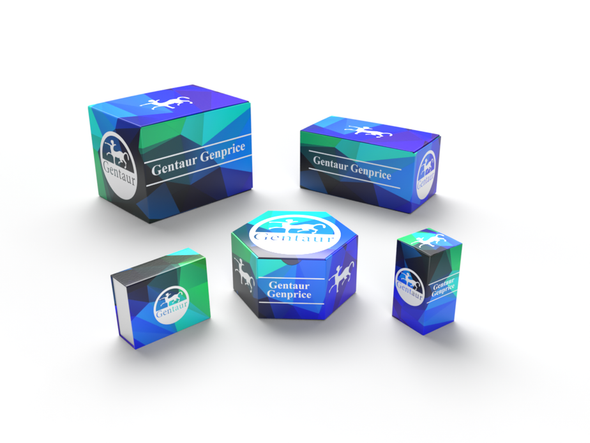LBD
KCNA1 Antibody (Center) [AMM06077G]
- SKU:
- LBD-AMM06077G
- Availability:
- Usually ships in 5 working days
Description
KCNA1 Antibody (Center) [AMM06077G] | Gentaur UK, US & Europe Distribution
Product Category: Polyclonal Antibodies
Host: Rabbit
Species Reactivity: H
Specificity: This KCNA1 antibody is generated from rabbits immunized with a KLH conjugated synthetic peptide between 172-201 amino acids from the Central region of human KCNA1.
Cellular Localisation: Cell membrane; Multi-pass membrane protein. Membrane Cell projection, axon. Cytoplasmic vesicle. Perikaryon {ECO:0000250|UniProtKB:P10499}. Endoplasmic reticulum {ECO:0000250|UniProtKB:P10499}. Cell projection, dendrite {ECO:0000250|UniProtKB:P16388}. Cell junction {ECO:0000250|UniProtKB:P16388}. Cell junction, synapse {ECO:0000250|UniProtKB:P16388}. Cell junction, synapse, presynaptic cell membrane {ECO:0000250|UniProtKB:P10499}. Cell junction, synapse, presynapse {ECO:0000250|UniProtKB:P16388}. Note=Homotetrameric KCNA1 is primarily located in the endoplasmic reticulum. Interaction with KCNA2 and KCNAB2 or with KCNA4 and KCNAB2 promotes expression at the cell membrane (By similarity) . {ECO:0000250|UniProtKB:P10499, ECO:0000250|UniProtKB:P16388}
Molecular Weight: 56466
Clone: Polyclonal
Gene Name: KCNA1
Gene ID: 3736
Function: Voltage-gated potassium channel that mediates transmembrane potassium transport in excitable membranes, primarily in the brain and the central nervous system, but also in the kidney (PubMed:19903818) . Contributes to the regulation of the membrane potential and nerve signaling, and prevents neuronal hyperexcitability (PubMed:17156368) . Forms tetrameric potassium-selective channels through which potassium ions pass in accordance with their electrochemical gradient. The channel alternates between opened and closed conformations in response to the voltage difference across the membrane (PubMed:19912772) . Can form functional homotetrameric channels and heterotetrameric channels that contain variable proportions of KCNA1, KCNA2, KCNA4, KCNA5, KCNA6, KCNA7, and possibly other family members as well; channel properties depend on the type of alpha subunits that are part of the channel (PubMed:12077175, PubMed:17156368) . Channel properties are modulated by cytoplasmic beta subunits that regulate the subcellular location of the alpha subunits and promote rapid inactivation of delayed rectifier potassium channels (PubMed:12077175, PubMed:17156368) . In vivo, membranes probably contain a mixture of heteromeric potassium channel complexes, making it difficult to assign currents observed in intact tissues to any particular potassium channel family member. Homotetrameric KCNA1 forms a delayed-rectifier potassium channel that opens in response to membrane depolarization, followed by slow spontaneous channel closure (PubMed:19912772, PubMed:19968958, PubMed:19307729, PubMed:19903818) . In contrast, a heterotetrameric channel formed by KCNA1 and KCNA4 shows rapid inactivation (PubMed:17156368) . Regulates neuronal excitability in hippocampus, especially in mossy fibers and medial perforant path axons, preventing neuronal hyperexcitability. Response to toxins that are selective for KCNA1, respectively for KCNA2, suggests that heteromeric potassium channels composed of both KCNA1 and KCNA2 play a role in pacemaking and regulate the output of deep cerebellar nuclear neurons (By similarity) . May function as down-stream effector for G protein-coupled receptors and inhibit GABAergic inputs to basolateral amygdala neurons (By similarity) . May contribute to the regulation of neurotransmitter release, such as gamma-aminobutyric acid (GABA) release (By similarity) . Plays a role in regulating the generation of action potentials and preventing hyperexcitability in myelinated axons of the vagus nerve, and thereby contributes to the regulation of heart contraction (By similarity) . Required for normal neuromuscular responses (PubMed:11026449, PubMed:17136396) . Regulates the frequency of neuronal action potential firing in response to mechanical stimuli, and plays a role in the perception of pain caused by mechanical stimuli, but does not play a role in the perception of pain due to heat stimuli (By similarity) . Required for normal responses to auditory stimuli and precise location of sound sources, but not for sound perception (By similarity) . The use of toxins that block specific channels suggest that it contributes to the regulation of the axonal release of the neurotransmitter dopamine (By similarity) . Required for normal postnatal brain development and normal proliferation of neuronal precursor cells in the brain (By similarity) . Plays a role in the reabsorption of Mg (2+) in the distal convoluted tubules in the kidney and in magnesium ion homeostasis, probably via its effect on the membrane potential (PubMed:23903368, PubMed:19307729) .
Summary: Tissue Location: Detected adjacent to nodes of Ranvier in juxtaparanodal zones in spinal cord nerve fibers, but also in paranodal regions in some myelinated spinal cord axons (at protein level) (PubMed:11086297) . Detected in the islet of Langerhans (PubMed:21483673) .
Form: Purified polyclonal antibody supplied in PBS with 0.09% (W/V) sodium azide. This antibody is purified through a protein A column, followed by peptide affinity purification.
Storage: Maintain refrigerated at 2-8°C for up to 2 weeks. For long term storage store at -20°C in small aliquots to prevent freeze-thaw cycles.
Application: WB, IHC-P
Dilution: WB--1:1000 IHC-P--1:100~500
Synonyms: Potassium voltage-gated channel subfamily A member 1, Voltage-gated K (+) channel HuKI, Voltage-gated potassium channel HBK1, Voltage-gated potassium channel subunit Kv11, KCNA1

![KCNA1 Antibody (Center) [AMM06077G] KCNA1 Antibody (Center) [AMM06077G]](https://cdn11.bigcommerce.com/s-1rdwiq712m/images/stencil/608x608/products/56095/56399/gentaur-genprice__26005.1661610467__29809.1661628092__75433.1661676199__77988.1661684280__64362.1661692443__72357.1661836953.png?c=1)
![TRIB3 Antibody (C-term) [APR06077G] TRIB3 Antibody (C-term) [APR06077G]](https://cdn11.bigcommerce.com/s-1rdwiq712m/images/stencil/590x590/products/59449/59753/gentaur-genprice__26005.1661610467__29809.1661628092__75433.1661676199__77988.1661684280__64362.1661692443__63602.1661856259.png?c=1)



